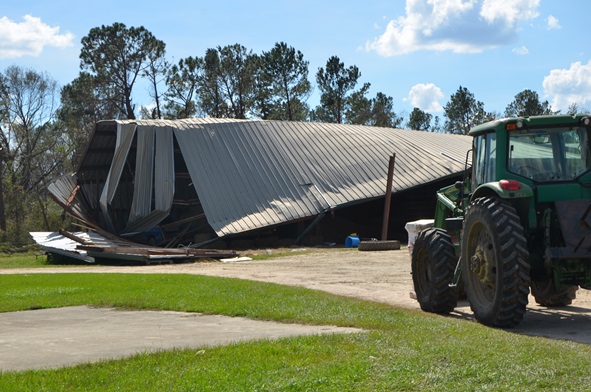
Mark Mauldin, Washington County Agriculture and Natural Resources Agent, speaks with a producer about his hurricane losses
Hurricane Michael will always be recalled as a milestone in the lives of many Florida Panhandle residents. The course of people’s lives has been altered irrevocably. Depending on the location within the storm’s footprint, the damage was minor to absolutely devastating. Any tangible asset in the path of the venial weather event was subject to traumatic physical abuse.
After the winds subsided, Extension faculty from every corner of the Northwest Extension District stepped out of the sheltering protection of their homes to assess personal damage and begin the recovery efforts for themselves, and the clients they serve. One of the many Extension initiatives undertaken to aid recovery efforts has been the assessment of damage to agricultural crops. State and Federal agencies, the news media, insurance companies and many more are interested in the monetary losses resulting from this category four storm.
Dr. Alan Hodges at the University of Florida’s Food and Resource Economics Department is the assembly point for the data. He provided a survey instrument which was developed in conjunction with district faculty and staff. The internet-based questionnaire was printed out by many who engaged farmers and livestock producers in areas where cellular service was inoperative because of hurricane damage.
“We went to check on the farmers and ranchers in the area to see what we can do to help their situation,” said Ethan Carter, Regional Crop Integrated Pest Management Agent who is based in Marianna, Florida. “All were happy to see us and willing to share their experiences,” he said. While assisting others, Carter’s house was unlivable. It had multiple large trees on the roof, some with piercing branches reaching the floor rendering the home a danger to enter for months to come.
“It was a bit challenging to navigate some of the roads, especially the dirt roads which were really rutted,” said Mark Mauldin, Washington County Agriculture and Natural Resources Agent. “Miles of fences are down, cattle scattered and the hay is wet. It will take a long time for producers to recover from this hit,” he said. Mauldin took his family to a safe location to ride out the storm, but returned to Chipley the day after the storm passed ready to serve his community. Like so many others, he was out of power for weeks, but did not have damage directly to his home.
Stacy Strickland, Osceola County Extension Director, led a team which worked on damage assessments in Jackson County. Jim Fletcher, Regional Specialized Water Agent from the Central Extension District, flew a drone over field and vegetable crops to collect photo images for spectral analysis assessment which is used to measure the longer term health prospects of crops.
The survey effort by Extension Agents is continuing in the effected counties. The injury to farms, cattle operations, specialty crop production and all other phase of agricultural are being collected to measure the damage and tell the story of Hurricane Michael’s wrath and the indomitable spirit of north Florida’s agriculture community.
To learn more about north Florida’s Extension Agent’s efforts to collect agricultural damage information, contact your local UF/IFAS County Extension Office.
- The Federal Reserve’s Beige Book Outlook for the Near Future - August 9, 2019
- Creeping Indigo: Get Ahead of the Problem Now - March 1, 2019
- Horse Hooves Need Extra Care in Wet Pastures - February 15, 2019

